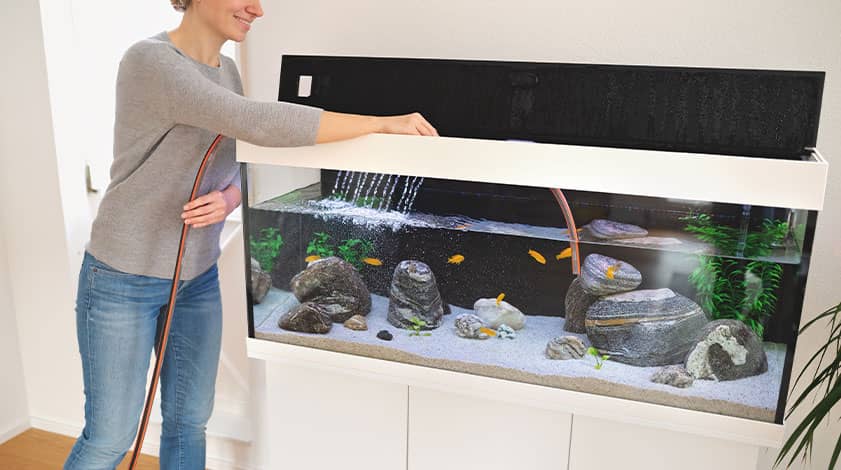Moving an Aquarium? Follow These 17 Simple Steps for a Safe and Easy Move!

Moving an aquarium and its fish inhabitants is a challenging task that requires careful planning and execution. The process can be stressful for both you and your fish, as it involves disassembling the aquarium, handling delicate and sensitive fish species, transporting everything safely, and reassembling the aquarium at your new home. To ensure the safety of your fish and maintain the integrity of the aquarium, it's crucial to follow a well-thought-out plan and take into consideration the unique needs of your aquatic pets.
In this comprehensive guide, we will walk you through every step of the process, from preparing for the move and packing your aquarium to transporting your fish safely and setting up your aquarium in your new home. By following these steps, you'll be able to minimize the stress on your fish and create a smooth transition to their new environment.
A. Prepare for the Move
#1 Determine the distance and duration of the move
Before you begin the moving process, it's essential to determine the distance and duration of the move. This will help you decide on the best approach for packing and transporting your aquarium and fish. Short moves may require less preparation, while long-distance moves might need extra considerations, such as overnight stays and temperature fluctuations.
#2 Gather necessary supplies and equipment
Once you've assessed the scope of the move, gather all the necessary supplies and equipment. These may include:
- Fish-safe containers or bags
- Insulated boxes or coolers
- Air pumps and battery-operated aerators
- Fish nets
- Towels or blankets for padding
- Tape, labels, and markers
- Buckets for transporting aquarium water
B. Assess Your Aquarium and Fish
#3 Check the health of the fish and consider postponing if necessary
Before moving your aquarium, make sure your fish are in good health. A move can be stressful, and sick or weak fish may not cope well with the process. If you notice any signs of illness, consult with a veterinarian or aquarium expert and consider postponing the move until your fish have recovered.
C. Schedule the Move
#4 Choose the most suitable day and time
Select a day and time for your move that will minimize stress on your fish and allow for ample preparation. Ideally, choose a day when you have no other obligations and can dedicate your full attention to the move. It's also a good idea to plan the move early in the day to avoid traffic and reduce the time your fish spend in transport containers.
#5 Consider weather, traffic, and potential stress on the fish
When scheduling your move, take into account factors that could impact the safety and well-being of your fish. Pay attention to the weather forecast and avoid moving during extreme temperatures or storms. Additionally, consider the traffic patterns in your area to ensure a smooth, stress-free trip for your fish.
D. Packing/Preparing Your Aquarium
#6 Remove decorations and clean the tank
Before disassembling your aquarium, remove all decorations, such as rocks, plants, and ornaments. Clean them thoroughly and set them aside for packing. You may also want to clean the tank itself, but avoid using any harsh chemicals or cleaning agents that could harm your fish. A simple wipe-down with a soft cloth or sponge should suffice.
#7 Drain water, leaving some for the fish during transport
Begin draining the aquarium water into a separate container, such as a large bucket. It's essential to leave some water in the tank for your fish during transport, as this will help maintain a stable environment and reduce stress. Aim to keep about one-third of the water in the tank.
E. Safely Packing Your Fish
#8 Use appropriate containers for each species
Select appropriate containers for each fish species based on their size, temperament, and special requirements. Smaller fish can be placed in fish-safe plastic bags with a suitable amount of water, while larger or more sensitive fish may require sturdier containers with lids. If possible, use containers that are insulated or have the ability to maintain a stable temperature during transport.
#9 Secure the containers to minimize stress and movement
Once your fish are in their respective containers, make sure they are securely closed and sealed to prevent leaks or spills. To minimize stress and movement during transport, wrap the containers with towels or blankets for padding, and place them in an insulated box or cooler. If you're using plastic bags, ensure that they are properly sealed and have enough air for the fish to breathe.
#10 Packing aquarium equipment
Carefully disassemble your aquarium equipment, such as filters, heaters, lights, and pumps. If necessary, consult the manufacturer's instructions for guidance on safely disassembling and packing each item. Wrap fragile components in bubble wrap or towels to prevent damage during transport.
#11 Label containers and keep small parts organized
As you pack your equipment, label each container or box with its contents and any special instructions for reassembly. Keeping everything organized will make setting up your aquarium in your new home much easier. For small parts, such as screws, clips, and tubing, consider using a tackle box or small plastic containers to keep them together and easily accessible.
F. Transporting Your Aquarium and Fish
#12 Choosing the right vehicle
When selecting a vehicle for your move, make sure there is enough space to accommodate the aquarium and all of its components, including the fish containers. The vehicle should have a flat, stable surface on which to place the aquarium to prevent it from tipping over or sliding during transit.
#13 Use a moving truck or van with temperature control
If possible, opt for a moving truck or van with temperature control capabilities. This will help maintain a stable environment for your fish and minimize stress during the move. If you're unable to secure a temperature-controlled vehicle, consider using portable heaters or coolers to regulate the temperature inside the vehicle.
G. Load the Aquarium and Fish Carefully
#14 Position the aquarium and fish containers securely
Load the aquarium and fish containers into the vehicle with care. Place the aquarium on a flat, stable surface and secure it using straps or bungee cords to prevent movement during transit. Arrange the fish containers so they are not stacked on top of one another, and use padding materials such as towels or blankets to provide additional support.
#15 Ensure proper ventilation and temperature control
Make sure the vehicle is well-ventilated to provide adequate oxygen for your fish during transport. Monitor the temperature inside the vehicle and make adjustments as needed to maintain a comfortable environment for your fish.
H. Drive Cautiously
#16 Avoid sudden stops or sharp turns
While transporting your aquarium and fish, drive cautiously to minimize stress and movement. Avoid sudden stops, sharp turns, or excessive acceleration, as these actions can cause the aquarium to shift or the fish containers to jostle.
#17 Keep an eye on the fish and aquarium throughout the journey
Regularly check on your fish and the aquarium during the move to ensure they are faring well. If you notice any signs of stress or discomfort, make any necessary adjustments to the vehicle's temperature or ventilation. By driving cautiously and monitoring your fish, you can ensure a safe and smooth relocation for your aquatic friends.
Conclusion
Moving an aquarium and its inhabitants can be a challenging task, but with proper planning and execution, it can be done safely and with minimal stress on your fish. Remember to take the time to prepare and pack everything carefully, choose a suitable vehicle for transport, and acclimate your fish to their new environment. By following these steps, you can create a smooth transition for your aquatic pets and enjoy your beautifully set-up aquarium in your new home











